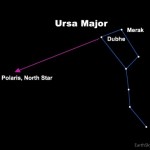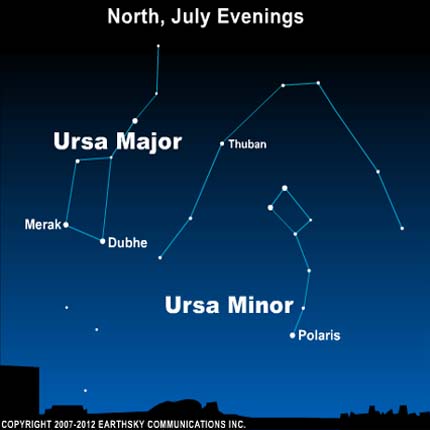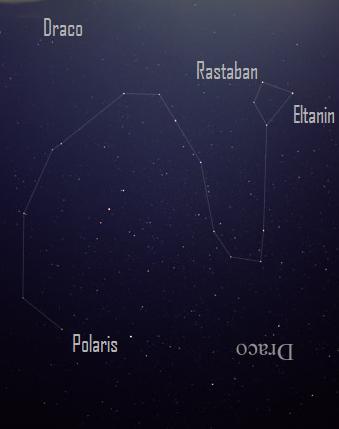
Tonight, use the Big Dipper in the constellation Ursa Major the Great Bear to find the sky’s northern pole star, Polaris. This is the star around which the whole northern celestial sphere appears to turn throughout the night. That’s because this star is located nearly above Earth’s northern axis. In times past, wanderers on the northern face of Earth used Polaris to stay on course.
Once you find it, you can also look for Thuban, a famous former pole star in the constellation Draco the Dragon. More about finding Thuban below.
So how can you find Polaris? Look at the chart at the top of this post. You’ll simply draw a line through the Big Dipper’s pointer stars – Dubhe and Merak. That line will point to Polaris, the North Star. You can use this trick to find Polaris any evening – no matter how the Dipper is oriented with respect to your northern horizon.

EarthSky community member Ken Christison captured these glorious star trails around Polaris, the North Star. This is the star around which the entire northern sky appears to turn.
Once you’ve got Polaris, if your sky is dark enough, you might be able to see the Little Dipper asterism. It’s harder to spot than the Big Dipper and needs a dark sky to be seen.
The chart below shows the Big Dipper, Little Dipper and the star Polaris as you’ll see them in the north on July evenings. Polaris marks the end of the handle on the Little Dipper asterism, which is in the constellation Ursa Minor.
In other words, the Little Dipper is not the whole constellation, but just a noticeable pattern within the constellation Ursa Minor the Smaller Bear.
Polaris isn’t the brightest star in the sky, as is commonly supposed. It’s only 50th brightest or so.
Still, Polaris is bright enough to be seen with relative ease on a dark, clear night.
Enjoying EarthSky so far? Sign up for our free daily newsletter today!

Orientation of Dippers on July evenings. Note that Polaris is the end star in the handle of the Little Dipper. And look at Thuban, between the Dippers.
How to find the star Thuban, and its constellation Draco the Dragon. As night deepens, and the fainter stars of the Little Dipper spring into view, those of you with dark-enough skies can expect to see a winding stream of stars between the Big and Little Dippers. These meandering stars make up the constellation Draco.
The star Thuban is one of the stars here, part of the Tail of the legendary constellation Draco the Dragon, a fixture of the northern skies. I always find Thuban by remembering it’s between the Big and Little Dippers.
Thuban is famous for having served as a pole star around 3000 B.C. This date coincides with the beginning of the building of the pyramids in Egypt. It’s said that the descending passage of the Great Pyramid of Khufu at Gizeh was built to point directly at Thuban. So our ancestors knew and celebrated this star.
More about Draco, the great Dragon of the north

Draco the Dragon as seen on early summer evenings from mid-northern latitudes. Image via Wikipedia/AlltheSky.com.
Bottom line: Draw a line through the Big Dipper pointer stars to find Polaris, Earth’s northern pole star. If your sky is dark, also look for a former pole star, Thuban.
July 2020 guide to the bright planets
Donate: Your support means the world to us
from EarthSky https://ift.tt/2Jgnlv8

Tonight, use the Big Dipper in the constellation Ursa Major the Great Bear to find the sky’s northern pole star, Polaris. This is the star around which the whole northern celestial sphere appears to turn throughout the night. That’s because this star is located nearly above Earth’s northern axis. In times past, wanderers on the northern face of Earth used Polaris to stay on course.
Once you find it, you can also look for Thuban, a famous former pole star in the constellation Draco the Dragon. More about finding Thuban below.
So how can you find Polaris? Look at the chart at the top of this post. You’ll simply draw a line through the Big Dipper’s pointer stars – Dubhe and Merak. That line will point to Polaris, the North Star. You can use this trick to find Polaris any evening – no matter how the Dipper is oriented with respect to your northern horizon.

EarthSky community member Ken Christison captured these glorious star trails around Polaris, the North Star. This is the star around which the entire northern sky appears to turn.
Once you’ve got Polaris, if your sky is dark enough, you might be able to see the Little Dipper asterism. It’s harder to spot than the Big Dipper and needs a dark sky to be seen.
The chart below shows the Big Dipper, Little Dipper and the star Polaris as you’ll see them in the north on July evenings. Polaris marks the end of the handle on the Little Dipper asterism, which is in the constellation Ursa Minor.
In other words, the Little Dipper is not the whole constellation, but just a noticeable pattern within the constellation Ursa Minor the Smaller Bear.
Polaris isn’t the brightest star in the sky, as is commonly supposed. It’s only 50th brightest or so.
Still, Polaris is bright enough to be seen with relative ease on a dark, clear night.
Enjoying EarthSky so far? Sign up for our free daily newsletter today!

Orientation of Dippers on July evenings. Note that Polaris is the end star in the handle of the Little Dipper. And look at Thuban, between the Dippers.
How to find the star Thuban, and its constellation Draco the Dragon. As night deepens, and the fainter stars of the Little Dipper spring into view, those of you with dark-enough skies can expect to see a winding stream of stars between the Big and Little Dippers. These meandering stars make up the constellation Draco.
The star Thuban is one of the stars here, part of the Tail of the legendary constellation Draco the Dragon, a fixture of the northern skies. I always find Thuban by remembering it’s between the Big and Little Dippers.
Thuban is famous for having served as a pole star around 3000 B.C. This date coincides with the beginning of the building of the pyramids in Egypt. It’s said that the descending passage of the Great Pyramid of Khufu at Gizeh was built to point directly at Thuban. So our ancestors knew and celebrated this star.
More about Draco, the great Dragon of the north

Draco the Dragon as seen on early summer evenings from mid-northern latitudes. Image via Wikipedia/AlltheSky.com.
Bottom line: Draw a line through the Big Dipper pointer stars to find Polaris, Earth’s northern pole star. If your sky is dark, also look for a former pole star, Thuban.
July 2020 guide to the bright planets
Donate: Your support means the world to us
from EarthSky https://ift.tt/2Jgnlv8

Aucun commentaire:
Enregistrer un commentaire